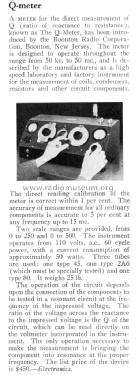Boonton Q-Meter 100-A
Boonton Radio Corp.; Boonton, NJ
- País
- Estados Unidos
- Fabricante / Marca
- Boonton Radio Corp.; Boonton, NJ
- Año
- 1935–1941

- Categoría
- Aparato de medida y servicio (Equipo de laboratorio).
- Radiomuseum.org ID
- 219490
Haga clic en la miniatura esquemática para solicitarlo como documento gratuito.
- Numero de valvulas
- 3
- Principio principal
- something special ? Please give information (notes)
- Gama de ondas
- Bandas de recepción puestas en notas.
- Tensión de funcionamiento
- Red: Corriente alterna (CA, Inglés = AC) / 110 Volt
- Altavoz
- - - No hay salida de sonido.
- Material
- Metálico
- de Radiomuseum.org
- Modelo: Boonton Q-Meter 100-A - Boonton Radio Corp.; Boonton,
- Forma
- Sobremesa de frontis inclinado.
- Anotaciones
- The Boonton Q-Meter Type 100-A covers 50 kc (kHz) to 50 mc (MHz). The direct reading calibration of the meter is correct within 1 %. The accuracy of measurement for all ordinary components is accurate to 5 per cent at any frequency up to 15 mc. Two scale ranges are provided, from 0 to 250 and 0 to 500. The instrument is for 110 volts, 60 cycles, with a current consumption of ca. 50 watts. The model type 100-A is the first Q-Meter at all and the first instrument of Boonton Radio Corp. The market introduction was May 1935 (see article in "Electronics". Q-meters measure the quality factor of coils and other components used in electronic devices and had broad applications in the testing of components and systems.
Direct successor is the Boonton Q-Meter 160-A - with its "syster model" 170-A. See Boonton "The Notebook".
Boonton, New Jersey-based Boonton Radio Corporation was founded in 1934 by W. D. Loughlin and several associates and was a manufacturer of electronic test instruments. The new firm concentrated its engineering skill on creating new measuring equipment for the still-young radio industry.
HP acquired Boonton in 1959 as a wholly-owned subsidiary. By then the firm had 150 employees and was a pioneer maker of precision instruments for measuring electrical circuit quality and checking aircraft guidance systems. In a year of phenomenal growth for HP (the company acquired three other firms in 1959), Boonton added to the HP family an old, well-established company with an excellent reputation in a field closely related to many HP products.
- Peso neto
- 25 lb (25 lb 0 oz) / 11.350 kg
- Precio durante el primer año
- 450.00 $
- Autor
- Modelo creado por Ernst Erb. Ver en "Modificar Ficha" los participantes posteriores.
- Otros modelos
-
Donde encontrará 20 modelos, 19 con imágenes y 10 con esquemas.
Ir al listado general de Boonton Radio Corp.; Boonton, NJ
Contribuciones en el Foro acerca de este modelo: Boonton Radio Corp.;: Boonton Q-Meter 100-A
Hilos: 1 | Mensajes: 1
There is a good article (PDF) by Henry P. Hall with the title: A History of Impedance Measurements":
ietlabs.com/pdf/GenRad_History/A_History_of_Z_Measurement.pdf
It begins with the early experimenters from 1775 to 1915, follows with the first commercial instruments 1900 to 1945, where in 2.5 can be found the following:
"Other Early Ac Instruments: Perhaps the most famous RF measuring instrument was the Boonton Radio Company's Type 100A "Q Meter" designed by C.J. Franks and W.D. Loughlin and introduced in 1934.
This popular instrument went through many revisions over the years with the BRC types 160-A appearing in 1939 (see figure 2-36) and 260-A in 1953 being the best known. Hewlett-Packard, who bought BRC, listed the type 4342A Q meter in its catalogs through 1993. In this circuit the unknown inductor is resonated against a variable capacitor whose dial reads inductance directly at certain frequencies and the inductor's Q value is proportional to the resonant peak voltage and is read on the scale of a vacuum-tube voltmeter."
You find this on page 25. The design was in 1934, but the first ad seems to appear May 1935. We believe this was the market introduction. Here you also find that the market introduction of the follower, the Type 160-A, was in 1939 but it could have been the design and introduction was later.
We would be thankful if you could send us some examples of ads or other information about the introduction but also about the follower instruments. We should be able to slowly get proofs by primary sources for such dates - including the end of a production - which can be seen in catalogs.
As a guest you can use the contact form. Thank you.
Ernst Erb, 28.May.12


